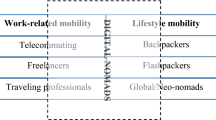Abstract
Although the study of the role of the social context in travel behavior and activity patterns has recently gained attention, the empirical evidence supporting the relationship between social networks and the temporal and spatial characteristics of social activities is still limited. With this motivation, this paper studies the link between “longer term” (social networks) and “shorter term” (social activities) social decisions, by exploring the intertwined relationship between the individuals’ personal networks attributes, and the spatiotemporal characteristics of their daily social activities. The paper contributes to the literature by adding two key aspects to the study of the role of social networks on travel behavior: the social networks’ structure, and the spatiality of all individuals participating on the social activities. Based on data which link people’s personal networks and time use, and using a structural equation modeling approach, the paper studies the influence of individual and interactional attributes on the duration, distance, and number of people involved in social daily activities. The results show that aspects such as tie social closeness, gender and age similarity, and network density, help to understand social activity duration and distance, complementing traditional socio-demographic aspects such as income, occupation, and accessibility to services. In this way, socio-demographic attributes are not enough to explain the spatiotemporal dimension of daily activities which makes necessary to include variables related to the social context to explain with a higher level of accuracy both the duration and distance traveled to the activity.


Similar content being viewed by others
References
Arbuckle, J.L.: Amos 20.0 User’s Guide. AMOS Development Corporation, Crawfordville (2011)
Arentze, T., Timmermans, H.: Social networks, social interactions, and activity-travel behavior: a framework for microsimulation. Environ. Plan. B 35(6), 1012–1027 (2008)
Axhausen, K.: Social networks and travel: some hypotheses. In: Donaghy, K. (ed.) Social Aspects of Sustainable Transport: Transatlantic Perspectives. Ashgate, Aldershot (2005)
Carrasco, J.A., Hogan, B., Wellman, B., Miller, E.: Collecting social network data to study social activity-travel behaviour: an egocentred approach. Environ. Plan. B 35(6), 961–980 (2008)
Carrasco, J.A., Habib, K.: Understanding the social embeddedness of activity–travel participation: the case of frequency and duration of social activities. In: Paper Presented at the 12th International Association for Travel Behavior Research (IATBR) Conference, pp.13–18. Jaipur (2009)
Carrasco, J.A., Cid-Aguayo, B.: Network capital, social networks, and travel: an empirical illustration from Concepción, Chile. Environ. Plan. A 44(5), 1066–1084 (2012)
Doherty, S., Nemeth, E., Roorda, M., Miller, E.: Design and assessment of the toronto area computerized household activity scheduling survey. Transp. Res. Rec. J. Transp. Res. Board 1894, 140–149 (2004)
Frei, A., Axhausen, K.: Size and structure of social network geographies. Arbeitsberichte Verkehrs- und Raumplanung 439. IVT, ETH Zürich, Zürich (2007)
Golob, T.: Structural equation modeling for travel behavior research. Transp. Res. B 37, 1–25 (2003)
Habib, K., Carrasco, J.A., Miller, E.: Social context of activity scheduling: discrete-continuous model of relationship between “with whom” and episode start time and duration. Transp. Res. Rec. J. Transp. Res. Board 2076, 81–87 (2008)
Habib, K., Carrasco, J.A.: Investigating the role of social networks in start time and duration of activities: a trivariate simultaneous econometric model. Transp. Res. Rec J. Transp. Res. Board 2230, 1–8 (2011)
Kowald, M., Axhausen, K.: Focusing on connected personal networks: selected results from a snowball sample. Environ. Plan. A 44(5), 1085–1100 (2012)
Kowald, M., Arentze, T., Axhausen, K.: A population’s leisure network: descriptive statistics and a model-based analysis of leisure-contact selection. In: Paper Presented at the 13th International Conference on Travel Behavior Research (IATRB). pp. 15–20, Toronto (2012)
Mok, D., Wellman, B., Carrasco, J.A.: Does distance still matter in connected lives? A pre- and post-internet comparison. Urban Stud 47(13), 2747–2784 (2010)
Rainie, L., Wellman, B.: Networked: The New Social Operating System. MIT Press, Cambridge (2012)
Ronald, N., Arentze, T., Timmermans, H.: Modeling social interactions between individuals for joint activity scheduling. Transp. Res. B 46(2), 276–290 (2012)
Sener, I., Bhat, C., Pendyala, R.: When, where, how long, and with whom are individuals participating in physically active recreational episodes? In: Paper Presented at the 90th Annual Meeting of the Transportation Research Board, pp. 23–27. Washington DC (2011)
Sharmeen, F., Arentze, T., Timmermans, H.: Modelling the dynamics between social networks and activity-travel behavior: framework and research agenda. In: Paper Presented at the 12th World Conference on Transport Research (WCTR), pp. 11–15. Lisbon (2010)
Stopher, P.: Collecting, Managing, and Assessing Data Using Sample Surveys. Cambridge University Press, New York (2012)
Urry, J.: Social networks, travel and talk. Brit. J. Soc. 54(2), 155–175 (2003)
Van den Berg, P., Arentze, T., Timmermans, H.: Size and composition of ego-centered social networks and their effect on geographic distance and contact frequency. Transp. Res. Rec. J. Transp. Res. Board 2135, 1–9 (2009)
Van den Berg, P., Arentze, T., Timmermans, H.: A path analysis of social networks, ICT use and social activity-travel patterns in The Netherlands. In: Paper Presented at the12th World Conference on Transport Research (WCTR), pp. 11–15. Lisbon (2010)
Van den Berg, P., Arentze, T., Timmermans, H.: A latent class accelerated hazard model of social activity duration. Transp. Res. A 46, 12–21 (2012a)
Van den Berg, P., Arentze, T., Timmermans, H.: Involvement in clubs or voluntary associations, social networks and activity generation: a path analysis. Transportation 39(4), 843–856 (2012b)
Washington, S., Karlaftis, M., Mannering, F.: Statistical and Econometric Methods for Transportation Data Analysis. Chapman & Hall/CRC, Washington (2003)
Acknowledgments
This research was funded by the Chilean Research, Science, and Technology Council (CONICYT), Programa de Financiamiento Basal para Centros de Excelencia FBO-16 and Fondecyt 1110920.
Author information
Authors and Affiliations
Corresponding author
Rights and permissions
About this article
Cite this article
Moore, J., Carrasco, JA. & Tudela, A. Exploring the links between personal networks, time use, and the spatial distribution of social contacts. Transportation 40, 773–788 (2013). https://doi.org/10.1007/s11116-013-9467-4
Published:
Issue Date:
DOI: https://doi.org/10.1007/s11116-013-9467-4




